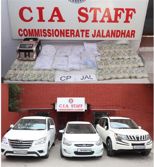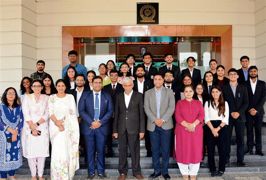
Diplomatic parleys: The 29th meeting of the Working Mechanism for Consultation and Coordination on India-China Border Affairs was held in Beijing last week. PTI
C Uday Bhaskar
Director, Society for Policy Studies
INDIA’S most serious security setback over the past five years was the Galwan surprise of June 2020, when Chinese troops violated the peace and tranquillity agreements along the Line of Actual Control (LAC). For the first time in decades, soldiers were killed on both sides. The Chinese People’s Liberation Army has since prevented India from patrolling areas on its own side of the disputed line, as was the normal practice. A sullen standoff continues, with over 100,000 troops deployed, and there is no resolution in sight.
As many as 21 rounds of talks between senior military commanders have been held, but there has been limited progress in de-escalation and disengagement. One presumes this will be a major issue for deliberations at the Army Commanders’ Conference to be held in New Delhi (April 1-2). The keynote address to be delivered by Defence Minister Rajnath Singh on April 2 may provide insights into the politico-military policies that New Delhi will adopt, even as the country prepares for the General Election.
At the diplomatic level, the 29th meeting of the Working Mechanism for Consultation and Coordination on India-China Border Affairs was held in Beijing on March 27. Little tangible progress was reported, barring the reiteration that “both sides agreed to maintain regular contact”.
When the Galwan clash happened (during the Covid pandemic) it was a shock for the Indian security establishment. At the time, the issue was obfuscated by the political apex and after the initial emotive outburst, the challenge from China was pushed to the backburner. A convoluted interpretation was encouraged to suggest that since the almost 4,000-km-long LAC was yet to be demarcated in a consensual manner, “no Indian territory” was lost or forfeited. It was evident that the Modi government did not want to go down Nehru’s path of October 1962.
However, in an encouraging development, External Affairs Minister (EAM) S Jaishankar has in a lucid and unambiguous manner laid out the contours of the Galwan setback. Speaking in Kuala Lumpur last week, the EAM emphasised that restoring normalcy in the bilateral relations with China hinged on the conventional deployment of troops, which would serve as a necessary condition for shaping the future relationship with Beijing.
The word ‘normalcy’ is important here. The minister added: “We are still negotiating with the Chinese. I talk to my counterpart. We meet from time to time. Our military commanders negotiate with each other. But we are very clear that we had an agreement. There is a Line of Actual Control. We have a tradition of not bringing troops to that line. Both of us have bases some distance away, which is our traditional deployment place. And we want that normalcy.” He elucidated that normalcy returning “to where we are in terms of the troop deployment will be the basis for the relationship going forward”.
While the diplomatic position apropos of the Galwan incident has been spelt out with commendable clarity, the challenge for India is to persuade/prevail upon/compel China to restore this normalcy. Here the tenet of inter-state relations merits a recall: for diplomacy to succeed, it must be supported by appropriate national military capability and strategic resolve.
In an unexpected manner, this aspect of India’s military discomfiture was highlighted by Defence Secretary Giridhar Aramane at an India-US forum (February 21), where he referred to the standoff with China: “We are standing against a bully in a very determined fashion. And we expect that our friend, the US, will be there with us in case we need their support.”
It is rare for an Indian Defence Secretary to make such an explicit statement about a neighbour such as China and even less so to solicit support from a third party at a public forum. One presumes that there must have been some instruction from the PMO for such signalling to the principal interlocutors, but the more significant strand is the American response.
When asked specifically about US support to India if such an exigency were to arise, the US Deputy Secretary of State Richard Verma replied: “The US-India relationship stands on its own. And it stands on its own to send a very strong signal about the power of democracy, about the free and open Indo-Pacific, about the rules-based order, about inclusive societies where minority rights are protected. These are the kinds of principles and ideas that we stand for and that we will uphold. So, this isn’t about any third country.”
The inference that follows is that New Delhi cannot presume that the US will come to its assistance militarily against China — if there is a requirement — and India will have to pursue its ‘ekla chalo’ (walk alone) approach, as it did in October 1962.
The onus to make India more effective and assured in dealing with a Galwan-type challenge will lie with the Indian military, and this remains a work in progress. Whether it is the creation of the post of the CDS, corporatising public sector defence production units or introducing the Agnipath scheme, the outcome on the combat edge of the military is yet to be realised in a substantive manner. The military inventory for all three armed forces is below desirable levels and more funding is imperative. Indigenisation of major platforms remains uneven and the domestic design and manufacturing ecosystem is still evolving. The impact of Nepali Gorkha recruits no longer joining the Indian military and the long-term ramifications for the Army merit an objective review, as also the investment China is making in Nepal.
After the elections, a new government will assume office by early June, ahead of the fourth anniversary of the Galwan clash. Managing the China relationship with strategic clarity, technological perspicacity and tactical resolve is critical.
Join Whatsapp Channel of The Tribune for latest updates.



























